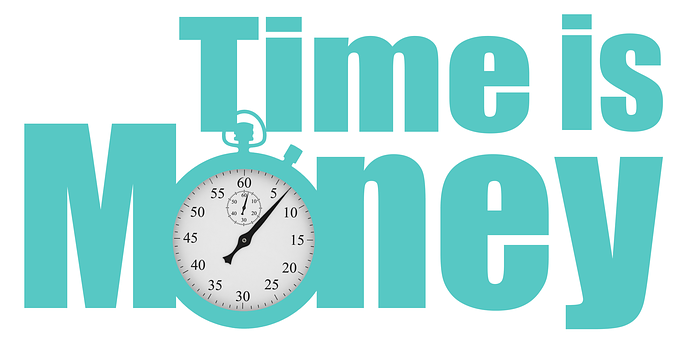
TIME IS MONEY is a common conceptual metaphor. (Image by geralt via Pixabay.)
While you think that you leave metaphors restricted within the four walls of your English classroom, you might be surprised by how often metaphorical language slips into your speech.
This phenomenon happens regularly through what linguists call conceptual metaphors. The Conceptual Metaphor Theory (CMT) claims that metaphorical language is abundant in the everyday speech of native speakers, and said metaphorical language affects our thoughts and behaviors as well as our speech patterns (Rasse et al. 311). Our use of conceptual metaphors is often done unconsciously, and conceptual metaphors are, by nature, indirect. Instead of calling one concept another, in conceptual metaphors, a source domain is mapped onto a target domain. In other words, as language related to one concrete concept (source domain) is applied to the other, more abstract concept (target domain), the two things are indirectly compared.
There are several major conceptual metaphors that manifest in the English language with native speakers:
One example of a conceptual metaphors that we often use is TIME IS MONEY. We often talk about time as if it’s something tangible, something that can be owned or lost. We spend time, we waste time, we invest time (Perdawdy, slide 24). All of these verbs directly relate to money (the source domain), but, in those contexts, they have been applied to the abstract concept of time (the target domain). This conceptual metaphor has many implications for how we view time as a society.

We often equate money and time management through the TIME IS MONEY conceptual metaphor, and this connection has important ramifications for our societal beliefs about time. (Image by tskirde via Pixabay.)
Another common conceptual metaphor is LOVE IS A JOURNEY. We often speak about relationships, particularly romantic relationships, as they will arrive at a destination or as if they are constantly in motion. We say things like, “this relationship has gone off track,” or, “look how far we’ve come,” or, “we’re at a crossroads in our relationship” (Perdawdy, slide 19). In this metaphor, the characteristics of the concrete concept of a journey (source domain) are applied to the more abstract concept of a romantic relationship (target domain).


There are many other examples of common conceptual metaphors: THE MIND IS A MACHINE (“I can see the gears turning in your head”), GOOD IS UP and BAD IS DOWN (feeling “up” and feeling “down”), ARGUMENT IS WAR (“she defended her claim”), IDEAS ARE FOOD (“food for thought,” half-baked idea,” “raw data,” etc.), and more (Peradawdy, slides 28, 31, 18, & 20).


The next time you have a conversation, try to keep track of how often you use metaphorical language. It probably happens more often than you’d think.
Works Cited
Perdawady, Ismail. “Conceptual Metaphors.” Slide Share, 11 Jan. 2018, https://www.slideshare.net/perdawdy/conceptual-metaphors.
Rasse, Carina et al. “Conceptual Metaphors in Poetry Interpretation: A Psycholinguistic Approach.” Language and Cognition, vol. 12, no. 2, Cambridge University Press, 28, Feb. 2020, pp. 310-342. Google Scholar, doi:10.1017/langcog.2019.47.
Danielle | 2022